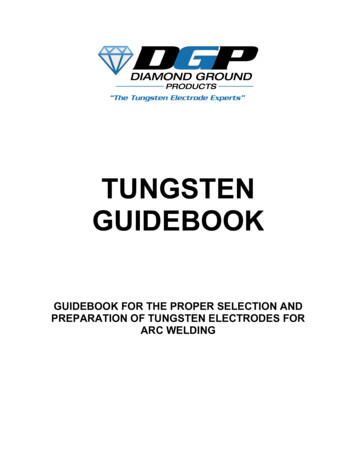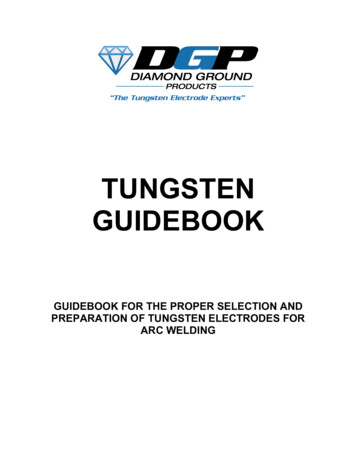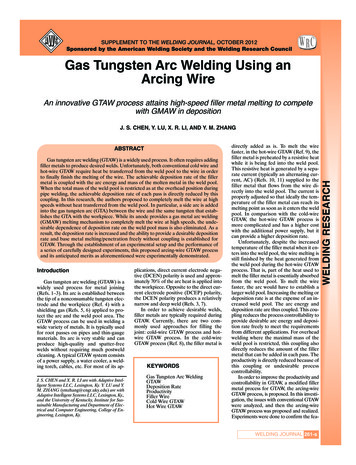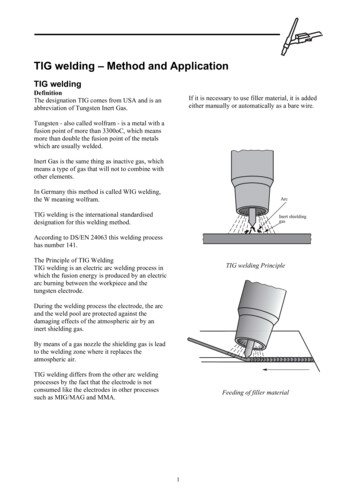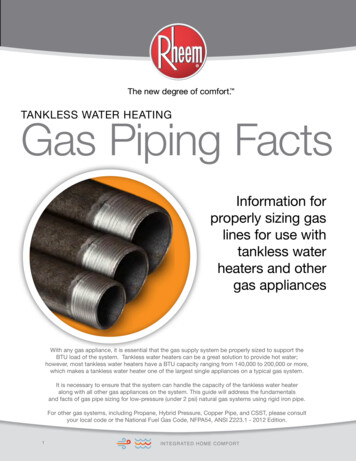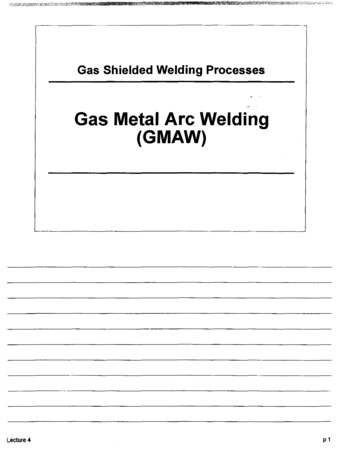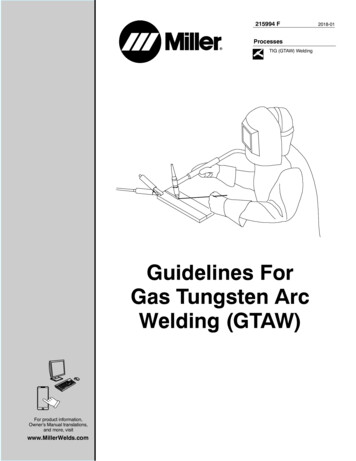
Transcription
215994 FProcessesTIG (GTAW) WeldingGuidelines ForGas Tungsten ArcWelding (GTAW)For product information,Owner’s Manual translations,and more, visitwww.MillerWelds.com2018-01
TABLE OF CONTENTSSECTION 1 SAFETY PRECAUTIONS - READ BEFORE USING . . . . . . . . . . . . . . . . . . . . . . . . . . . . . . . . . . .1-1. Symbol Usage . . . . . . . . . . . . . . . . . . . . . . . . . . . . . . . . . . . . . . . . . . . . . . . . . . . . . . . . . . . . . . . . . . . . . . . .1-2. Arc Welding Hazards . . . . . . . . . . . . . . . . . . . . . . . . . . . . . . . . . . . . . . . . . . . . . . . . . . . . . . . . . . . . . . . . . .1-3. Additional Symbols For Installation, Operation, And Maintenance . . . . . . . . . . . . . . . . . . . . . . . . . . . . .1-4. California Proposition 65 Warnings . . . . . . . . . . . . . . . . . . . . . . . . . . . . . . . . . . . . . . . . . . . . . . . . . . . . . . .1-5. Principal Safety Standards . . . . . . . . . . . . . . . . . . . . . . . . . . . . . . . . . . . . . . . . . . . . . . . . . . . . . . . . . . . . .1-6. EMF Information . . . . . . . . . . . . . . . . . . . . . . . . . . . . . . . . . . . . . . . . . . . . . . . . . . . . . . . . . . . . . . . . . . . . . .SECTION 2 PRINCIPLES OF GAS TUNGSTEN ARC WELDING (GTAW) . . . . . . . . . . . . . . . . . . . . . . . . . . .2-1. Process Description . . . . . . . . . . . . . . . . . . . . . . . . . . . . . . . . . . . . . . . . . . . . . . . . . . . . . . . . . . . . . . . . . . .2-2. Selecting A GTAW Power Source . . . . . . . . . . . . . . . . . . . . . . . . . . . . . . . . . . . . . . . . . . . . . . . . . . . . . . . .2-3. Typical GTAW Welding System . . . . . . . . . . . . . . . . . . . . . . . . . . . . . . . . . . . . . . . . . . . . . . . . . . . . . . . . . .SECTION 3 GAS TUNGSTEN ARC WELDING (GTAW) PROCEDURE . . . . . . . . . . . . . . . . . . . . . . . . . . . . .3-1. Typical GTAW Welding Set-Up . . . . . . . . . . . . . . . . . . . . . . . . . . . . . . . . . . . . . . . . . . . . . . . . . . . . . . . . . .SECTION 4 SELECTING AND PREPARING A TUNGSTEN FOR DC ORAC WELDING WITH INVERTER MACHINES . . . . . . . . . . . . . . . . . . . . . . . . . . . . . . . . . . . . . . . . . . . . . . . . . . . . .4-1.Selecting Tungsten Electrode (Wear Clean Gloves To Prevent Contamination Of Tungsten) . . . . . . . . .4-2.Preparing Tungsten Electrode For DC Electrode Negative (DCEN) WeldingOr AC Welding With Inverter Machines . . . . . . . . . . . . . . . . . . . . . . . . . . . . . . . . . . . . . . . . . . . . . . . . . . .SECTION 5 GTAW WAVEFORMS . . . . . . . . . . . . . . . . . . . . . . . . . . . . . . . . . . . . . . . . . . . . . . . . . . . . . . . . . . . . .SECTION 6 ARC SHAPING CAPABILITIES . . . . . . . . . . . . . . . . . . . . . . . . . . . . . . . . . . . . . . . . . . . . . . . . . . . .6-1. Arc Starting With Different Polarities . . . . . . . . . . . . . . . . . . . . . . . . . . . . . . . . . . . . . . . . . . . . . . . . . . . . . .6-2. Balance Control . . . . . . . . . . . . . . . . . . . . . . . . . . . . . . . . . . . . . . . . . . . . . . . . . . . . . . . . . . . . . . . . . . . . . .6-3. AC Frequency Adjustment Control . . . . . . . . . . . . . . . . . . . . . . . . . . . . . . . . . . . . . . . . . . . . . . . . . . . . . . .6-4. Independent Amperage Control . . . . . . . . . . . . . . . . . . . . . . . . . . . . . . . . . . . . . . . . . . . . . . . . . . . . . . . . .6-5. Frequency Adjustment Control - 60 Hz . . . . . . . . . . . . . . . . . . . . . . . . . . . . . . . . . . . . . . . . . . . . . . . . . . .6-6. Frequency Adjustment Control - 200 Hz . . . . . . . . . . . . . . . . . . . . . . . . . . . . . . . . . . . . . . . . . . . . . . . . . .SECTION 7 TIG SHIELDING GASES . . . . . . . . . . . . . . . . . . . . . . . . . . . . . . . . . . . . . . . . . . . . . . . . . . . . . . . . . .7-1. Shielding Gases For TIG Welding . . . . . . . . . . . . . . . . . . . . . . . . . . . . . . . . . . . . . . . . . . . . . . . . . . . . . . . .SECTION 8 GUIDELINES FOR GTAW WELDING (TIG) . . . . . . . . . . . . . . . . . . . . . . . . . . . . . . . . . . . . . . . . . .8-1. Lift-Arc And HF TIG Start Procedures . . . . . . . . . . . . . . . . . . . . . . . . . . . . . . . . . . . . . . . . . . . . . . . . . . .8-2. Torch Movement During Welding . . . . . . . . . . . . . . . . . . . . . . . . . . . . . . . . . . . . . . . . . . . . . . . . . . . . . . . .8-3. Suggested Inverter Power Source Starting Parameters For Various Aluminum Joints . . . . . . . . . . . . .8-4. TIG Welding Techniques . . . . . . . . . . . . . . . . . . . . . . . . . . . . . . . . . . . . . . . . . . . . . . . . . . . . . . . . . . . . . . .8-5. Weld Test . . . . . . . . . . . . . . . . . . . . . . . . . . . . . . . . . . . . . . . . . . . . . . . . . . . . . . . . . . . . . . . . . . . . . . . . . . . .SECTION 9 GTAW TROUBLESHOOTING . . . . . . . . . . . . . . . . . . . . . . . . . . . . . . . . . . . . . . . . . . . . . . . . . . . . . .9-1. Troubleshooting . . . . . . . . . . . . . . . . . . . . . . . . . . . . . . . . . . . . . . . . . . . . . . . . . . . . . . . . . . . . . . . . . . . . . 18
SECTION 1 SAFETY PRECAUTIONS - READ BEFORE USINGsom 2018 017Protect yourself and others from injury — read, follow, and save these important safety precautions and operating instructions.1-1. Symbol UsageDANGER! Indicates a hazardous situation which, ifnot avoided, will result in death or serious injury. Thepossible hazards are shown in the adjoining symbolsor explained in the text.Indicates a hazardous situation which, if not avoided,could result in death or serious injury. The possiblehazards are shown in the adjoining symbols or explained in the text.NOTICE Indicates statements not related to personal injury. Indicates special instructions.This group of symbols means Warning! Watch Out! ELECTRICSHOCK, MOVING PARTS, and HOT PARTS hazards. Consult symbols and related instructions below for necessary actions to avoid thehazards.1-2. Arc Welding HazardsThe symbols shown below are used throughout this manualto call attention to and identify possible hazards. When yousee the symbol, watch out, and follow the related instructionsto avoid the hazard. The safety information given below isonly a summary of the more complete safety informationfound in the Safety Standards listed in Section 1-5. Read andfollow all Safety Standards.Only qualified persons should install, operate, maintain, andrepair this equipment. A qualified person is defined as onewho, by possession of a recognized degree, certificate, orprofessional standing, or who by extensive knowledge, training and experience, has successfully demonstrated ability tosolve or resolve problems relating to the subject matter, thework, or the project and has received safety training to recognize and avoid the hazards involved.During operation, keep everybody, especially children, away.ELECTRIC SHOCK can kill.Touching live electrical parts can cause fatal shocksor severe burns. The electrode and work circuit iselectrically live whenever the output is on. The inputpower circuit and machine internal circuits are alsolive when power is on. In semiautomatic or automaticwire welding, the wire, wire reel, drive roll housing,and all metal parts touching the welding wire areelectrically live. Incorrectly installed or improperlygrounded equipment is a hazard.D Do not touch live electrical parts.D Wear dry, hole-free insulating gloves and body protection.D Insulate yourself from work and ground using dry insulating matsor covers big enough to prevent any physical contact with the workor ground.D Do not use AC weld output in damp, wet, or confined spaces, or ifthere is a danger of falling.D Use AC output ONLY if required for the welding process.D If AC output is required, use remote output control if present onunit.D Additional safety precautions are required when any of the following electrically hazardous conditions are present: in damplocations or while wearing wet clothing; on metal structures suchas floors, gratings, or scaffolds; when in cramped positions suchas sitting, kneeling, or lying; or when there is a high risk of unavoidable or accidental contact with the workpiece or ground. For theseconditions, use the following equipment in order presented: 1) asemiautomatic DC constant voltage (wire) welder, 2) a DC manual(stick) welder, or 3) an AC welder with reduced open-circuit voltage. In most situations, use of a DC, constant voltage wire welderis recommended. And, do not work alone!D Disconnect input power or stop engine before installing orservicing this equipment. Lockout/tagout input power according toOSHA 29 CFR 1910.147 (see Safety Standards).D Properly install, ground, and operate this equipment according toits Owner’s Manual and national, state, and local codes.D Always verify the supply ground check and be sure that inputpower cord ground wire is properly connected to ground terminal indisconnect box or that cord plug is connected to a properlygrounded receptacle outlet.D When making input connections, attach proper grounding conductor first double-check connections.D Keep cords dry, free of oil and grease, and protected from hot metaland sparks.D Frequently inspect input power cord and ground conductor fordamage or bare wiring – replace immediately if damaged – barewiring can kill.D Turn off all equipment when not in use.D Do not use worn, damaged, undersized, or repaired cables.D Do not drape cables over your body.D If earth grounding of the workpiece is required, ground it directlywith a separate cable.D Do not touch electrode if you are in contact with the work, ground,or another electrode from a different machine.D Do not touch electrode holders connected to two welding machines at the same time since double open-circuit voltage will bepresent.D Use only well-maintained equipment. Repair or replace damagedparts at once. Maintain unit according to manual.D Wear a safety harness if working above floor level.D Keep all panels and covers securely in place.D Clamp work cable with good metal-to-metal contact to workpieceor worktable as near the weld as practical.D Insulate work clamp when not connected to workpiece to preventcontact with any metal object.D Do not connect more than one electrode or work cable to anysingle weld output terminal. Disconnect cable for process not inuse.D Use GFCI protection when operating auxiliary equipment in dampor wet locations.SIGNIFICANT DC VOLTAGE exists in inverter welding power sources AFTER removal of input power.D Turn off unit, disconnect input power, and discharge input capacitors according to instructions in Manual before touching any parts.HOT PARTS can burn.D Do not touch hot parts bare handed.D Allow cooling period before working onequipment.D To handle hot parts, use proper tools and/or wear heavy, insulated welding gloves and clothing to prevent burns.OM-215994 Page 1
FUMES AND GASES can be hazardous.Welding produces fumes and gases. Breathingthese fumes and gases can be hazardous to yourhealth.D Keep your head out of the fumes. Do not breathe the fumes.D Ventilate the work area and/or use local forced ventilation at the arcto remove welding fumes and gases. The recommended way todetermine adequate ventilation is to sample for the compositionand quantity of fumes and gases to which personnel are exposed.D If ventilation is poor, wear an approved air-supplied respirator.D Read and understand the Safety Data Sheets (SDSs) and themanufacturer’s instructions for adhesives, coatings, cleaners,consumables, coolants, degreasers, fluxes, and metals.D Work in a confined space only if it is well ventilated, or whilewearing an air-supplied respirator. Always have a trained watchperson nearby. Welding fumes and gases can displace air andlower the oxygen level causing injury or death. Be sure the breathing air is safe.D Do not weld in locations near degreasing, cleaning, or spraying operations. The heat and rays of the arc can react with vapors to formhighly toxic and irritating gases.D Do not weld on coated metals, such as galvanized, lead, orcadmium plated steel, unless the coating is removed from the weldarea, the area is well ventilated, and while wearing an air-suppliedrespirator. The coatings and any metals containing these elementscan give off toxic fumes if welded.ARC RAYS can burn eyes and skin.Arc rays from the welding process produce intensevisible and invisible (ultraviolet and infrared) raysthat can burn eyes and skin. Sparks fly off from theweld.D Wear an approved welding helmet fitted with a proper shade offilter lenses to protect your face and eyes from arc rays andsparks when welding or watching (see ANSI Z49.1 and Z87.1listed in Safety Standards).D Wear approved safety glasses with side shields under yourhelmet.D Use protective screens or barriers to protect others from flash,glare and sparks; warn others not to watch the arc.D Wear body protection made from durable, flame resistant material (leather, heavy cotton, wool). Body protection includesoil-free clothing such as leather gloves, heavy shirt, cufflesstrousers, high shoes, and a cap.WELDING can cause fire or explosion.Welding on closed containers, such as tanks,drums, or pipes, can cause them to blow up. Sparkscan fly off from the welding arc. The flying sparks, hotworkpiece, and hot equipment can cause fires andburns. Accidental contact of electrode to metal objects can causesparks, explosion, overheating, or fire. Check and be sure the area issafe before doing any welding.D Remove all flammables within 35 ft (10.7 m) of the welding arc. Ifthis is not possible, tightly cover them with approved covers.D Do not weld where flying sparks can strike flammable material.D Protect yourself and others from flying sparks and hot metal.D Be alert that welding sparks and hot materials from welding caneasily go through small cracks and openings to adjacent areas.D Watch for fire, and keep a fire extinguisher nearby.D Be aware that welding on a ceiling, floor, bulkhead, or partition cancause fire on the hidden side.OM-215994 Page 2D Do not cut or weld on tire rims or wheels. Tires can explode if heated. Repaired rims and wheels can fail. See OSHA 29 CFR1910.177 listed in Safety Standards.D Do not weld on containers that have held combustibles, or onclosed containers such as tanks, drums, or pipes unless they areproperly prepared according to AWS F4.1 and AWS A6.0 (seeSafety Standards).D Do not weld where the atmosphere can contain flammable dust,gas, or liquid vapors (such as gasoline).D Connect work cable to the work as close to the welding area aspractical to prevent welding current from traveling long, possiblyunknown paths and causing electric shock, sparks, and firehazards.D Do not use welder to thaw frozen pipes.D Remove stick electrode from holder or cut off welding wire atcontact tip when not in use.D Wear body protection made from durable, flame resistant material(leather, heavy cotton, wool). Body protection includes oil-freeclothing such as leather gloves, heavy shirt, cuffless trousers, highshoes, and a cap.D Remove any combustibles, such as a butane lighter or matches,from your person before doing any welding.D After completion of work, inspect area to ensure it is free of sparks,glowing embers, and flames.D Use only correct fuses or circuit breakers. Do not oversize or bypass them.D Follow requirements in OSHA 1910.252 (a) (2) (iv) and NFPA 51Bfor hot work and have a fire watcher and extinguisher nearby.D Read and understand the Safety Data Sheets (SDSs) and themanufacturer’s instructions for adhesives, coatings, cleaners,consumables, coolants, degreasers, fluxes, and metals.FLYING METAL or DIRT can injure eyes.D Welding, chipping, wire brushing, and grindingcause sparks and flying metal. As welds cool,they can throw off slag.D Wear approved safety glasses with sideshields even under your welding helmet.BUILDUP OF GAS can injure or kill.D Shut off compressed gas supply when not in use.D Always ventilate confined spaces or useapproved air-supplied respirator.ELECTRIC AND MAGNETIC FIELDS (EMF)can affect Implanted Medical Devices.D Wearers of Pacemakers and other ImplantedMedical Devices should keep away.D Implanted Medical Device wearers should consult their doctorand the device manufacturer before going near arc welding, spotwelding, gouging, plasma arc cutting, or induction heatingoperations.NOISE can damage hearing.Noise from some processes or equipment candamage hearing.D Wear approved ear protection if noise level is high.
CYLINDERS can explode if damaged.Compressed gas cylinders contain gas under highpressure. If damaged, a cylinder can explode. Sincegas cylinders are normally part of the weldingprocess, be sure to treat them carefully.D Protect compressed gas cylinders from excessive heat, mechanical shocks, physical damage, slag, open flames, sparks, and arcs.D Install cylinders in an upright position by securing to a stationarysupport or cylinder rack to prevent falling or tipping.D Keep cylinders away from any welding or other electrical circuits.D Never drape a welding torch over a gas cylinder.D Never allow a welding electrode to touch any cylinder.D Never weld on a pressurized cylinder explosion will result.D Use only correct compressed gas cylinders, regulators, hoses,and fittings designed for the specific application; maintain themand associated parts in good condition.D Turn face away from valve outlet when opening cylinder valve. Donot stand in front of or behind the regulator when opening the valve.D Keep protective cap in place over valve except when cylinder is inuse or connected for use.D Use the proper equipment, correct procedures, and sufficientnumber of persons to lift, move, and transport cylinders.D Read and follow instructions on compressed gas cylinders,associated equipment, and Compressed Gas Association (CGA)publication P-1 listed in Safety Standards.1-3. Additional Symbols For Installation, Operation, And MaintenanceFIRE OR EXPLOSION hazard.D Do not install or place unit on, over, or nearcombustible surfaces.D Do not install unit near flammables.D Do not overload building wiring be sure power supply system isproperly sized, rated, and protected to handle this unit.FALLING EQUIPMENT can injure.D Use lifting eye to lift unit only, NOT runninggear, gas cylinders, or any other accessories.D Use correct procedures and equipment of adequate capacity to lift and support unit.D If using lift forks to move unit, be sure forks are long enough toextend beyond opposite side of unit.D Keep equipment (cables and cords) away from moving vehicleswhen working from an aerial location.D Follow the guidelines in the Applications Manual for the RevisedNIOSH Lifting Equation (Publication No. 94 110) when manually lifting heavy parts or equipment.OVERUSE can cause OVERHEATINGD Allow cooling period; follow rated duty cycle.D Reduce current or reduce duty cycle beforestarting to weld again.D Do not block or filter airflow to unit.FLYING SPARKS can injure.D Wear a face shield to protect eyes and face.D Shape tungsten electrode only on grinder withproper guards in a safe location wearing properface, hand, and body protection.D Sparks can cause fires — keep flammables away.STATIC (ESD) can damage PC boards.D Put on grounded wrist strap BEFORE handlingboards or parts.D Use proper static-proof bags and boxes tostore, move, or ship PC boards.MOVING PARTS can injure.D Keep away from moving parts.D Keep away from pinch points such as driverolls.WELDING WIRE can injure.D Do not press gun trigger until instructed to doso.D Do not point gun toward any part of the body,other people, or any metal when threadingwelding wire.BATTERY EXPLOSION can injure.D Do not use welder to charge batteries or jumpstart vehicles unless it has a battery chargingfeature designed for this purpose.MOVING PARTS can injure.D Keep away from moving parts such as fans.D Keep all doors, panels, covers, and guardsclosed and securely in place.D Have only qualified persons remove doors, panels, covers, orguards for maintenance and troubleshooting as necessary.D Reinstall doors, panels, covers, or guards when maintenance isfinished and before reconnecting input power.READ INSTRUCTIONS.D Read and follow all labels and the Owner’sManual carefully before installing, operating, orservicing unit. Read the safety information atthe beginning of the manual and in eachsection.D Use only genuine replacement parts from the manufacturer.D Perform installation, maintenance, and service according to theOwner’s Manuals, industry standards, and national, state, andlocal codes.OM-215994 Page 3
H.F. RADIATION can cause interference.ARC WELDING can cause interference.D High-frequency (H.F.) can interfere with radionavigation, safety services, computers, andcommunications equipment.D Have only qualified persons familiar with electronic equipmentperform this installation.D The user is responsible for having a qualified electrician promptly correct any interference problem resulting from the installation.D If notified by the FCC about interference, stop using theequipment at once.D Have the installation regularly checked and maintained.D Keep high-frequency source doors and panels tightly shut, keepspark gaps at correct setting, and use grounding and shielding tominimize the possibility of interference.DDDDDD Electromagnetic energy can interfere withsensitive electronic equipment such ascomputers and computer-driven equipmentsuch as robots.Be sure all equipment in the welding area is electromagneticallycompatible.To reduce possible interference, keep weld cables as short aspossible, close together, and down low, such as on the floor.Locate welding operation 100 meters from any sensitive electronic equipment.Be sure this welding machine is installed and groundedaccording to this manual.If interference still occurs, the user must take extra measuressuch as moving the welding machine, using shielded cables,using line filters, or shielding the work area.1-4. California Proposition 65 WarningsWARNING: This product can expose you to chemicals including lead, which are known to the state of California tocause cancer and birth defects or other reproductiveharm.For more information, go to www.P65Warnings.ca.gov.1-5. Principal Safety StandardsSafety in Welding, Cutting, and Allied Processes, ANSI Standard Z49.1,is available as a free download from the American Welding Society athttp://www.aws.org or purchased from Global Engineering Documents(phone: 1-877-413-5184, website: www.global.ihs.com).Safe Practices for the Preparation of Containers and Piping for Weldingand Cutting, American Welding Society Standard AWS F4.1, from Global Engineering Documents (phone: 1-877-413-5184, website:www.global.ihs.com).Safe Practices for Welding and Cutting Containers that have Held Combustibles, American Welding Society Standard AWS A6.0, from GlobalEngineering Documents (phone: 1-877-413-5184,website: www.global.ihs.com).National Electrical Code, NFPA Standard 70, from National Fire Protection Association, Quincy, MA 02169 (phone: 1-800-344-3555, website:www.nfpa.org and www. sparky.org).Safe Handling of Compressed Gases in Cylinders, CGA Pamphlet P-1,from Compressed Gas Association, 14501 George Carter Way, Suite103, Chantilly, VA 20151 (phone: 703-788-2700, website:www.cganet.com).Safety in Welding, Cutting, and Allied Processes, CSA StandardW117.2, from Canadian Standards Association, Standards Sales, 5060Spectrum Way, Suite 100, Mississauga, Ontario, Canada L4W 5NS(phone: 800-463-6727, website: www.csagroup.org).Safe Practice For Occupational And Educational Eye And Face Protection, ANSI Standard Z87.1, from American National Standards Institute,25 West 43rd Street, New York, NY 10036 (phone: 212-642-4900, website: www.ansi.org).Standard for Fire Prevention During Welding, Cutting, and Other HotWork, NFPA Standard 51B, from National Fire Protection Association,Quincy, MA 02169 (phone: 1-800-344-3555, website: www.nfpa.org).OSHA, Occupational Safety and Health Standards for General Industry, Title 29, Code of Federal Regulations (CFR), Part 1910.177 SubpartN, Part 1910 Subpart Q, and Part 1926, Subpart J, from U.S. Government Printing Office, Superintendent of Documents, P.O. Box 371954,Pittsburgh, PA 15250-7954 (phone: 1-866-512-1800) (there are 10 OSHA Regional Offices—phone for Region 5, Chicago, is 312-353-2220,website: www.osha.gov).Applications Manual for the Revised NIOSH Lifting Equation, The National Institute for Occupational Safety and Health (NIOSH), 1600Clifton Rd, Atlanta, GA 30329-4027 (phone: 1-800-232-4636, website:www.cdc.gov/NIOSH).1-6. EMF InformationElectric current flowing through any conductor causes localized electricand magnetic fields (EMF). The current from arc welding (and allied processes including spot welding, gouging, plasma arc cutting, andinduction heating operations) creates an EMF field around the weldingcircuit. EMF fields can interfere with some medical implants, e.g. pacemakers. Protective measures for persons wearing medical implantshave to be taken. For example, restrict access for passers by or conduct individual risk assessment for welders. All welders should use thefollowing procedures in order to minimize exposure to EMF fields fromthe welding circuit:1. Keep cables close together by twisting or taping them, or using acable cover.2. Do not place your body between welding cables. Arrange cablesto one side and away from the operator.3. Do not coil or drape cables around your body.OM-215994 Page 44. Keep head and trunk as far away from the equipment in thewelding circuit as possible.5. Connect work clamp to workpiece as close to the weld aspossible.6. Do not work next to, sit or lean on the welding power source.7. Do not weld whilst carrying the welding power source or wirefeeder.About Implanted Medical Devices:Implanted Medical Device wearers should consult their doctor and thedevice manufacturer before performing or going near arc welding, spotwelding, gouging, plasma arc cutting, or induction heating operations.If cleared by your doctor, then following the above procedures is recommended.
SECTION 2 PRINCIPLES OF GAS TUNGSTEN ARCWELDING (GTAW)2-1. Process DescriptionGas Tungsten Arc Welding (GTAW), also known as tungsten inert gas (TIG) welding is a process that produces an electric arc maintained betweena nonconsumable tungsten electrode and the part to be welded. The heat-affected zone, the molten metal, and the tungsten electrode are all shieldedfrom atmospheric contamination by a blanket of inert gas fed through the GTAW torch. Inert gas (usually Argon) is inactive or deficient in active chemicalproperties. The shielding gas serves to blanket the weld and exclude the active properties in the surrounding air. Inert gases, such as Argon andHelium, do not chemically react or combine with other gases. They pose no odor and are transparent, permitting the the welder maximum visibilityof the arc. In some instances Hydrogen gas may be added to ehance travel speeds.The GTAW process can produce temperatures of up to 35,000 F (19,426 C). The torch contributes heat only to the workpiece. If filler metal is requiredto make the weld, it may be added manually in the same manner as it is added in the oxyacetylene welding process, or in other situations may be addedusing a cold wire feeder.GTAW is used to weld steel, stainless steel, nickel alloys such as Monel and Inconel , titanium, aluminum, magnesium, copper, brass, bronze, andeven gold. GTAW can also weld dissimilar metals to one another such as copper to brass and stainless steel to mild steel.Advantages of GTAW welding:D Concentrated Arc - Permits pinpoint control of heat input to the workpiece resulting in a narrow heat-affected zone.D No Slag - No requirement for flux with this process; therefore no slag to obscure the welder’s vision of the molten weld pool.D No Sparks or Spatter - No transfer of metal across the arc. No molten globules of spatter to contend with and no sparks produced if material beingwelded is free of contaminants.D Little Smoke or Fumes - Compared to other arc-welding processes like stick or flux cored welding, few fumes are produced. However, the basemetals being welded may contain coatings or elements such as lead, zinc, copper, and nickel that may produce hazardous fumes. Keep your headand helmet out of any fumes rising off the workpiece. Be sure that proper ventilation is supplied, especially in a confined space.D Welds more metals and metal alloys than any other arc welding process.D Good for welding thin material.D Good for welding dissimilar metals together.Disadvantages of GTAW welding:D Slower travel speeds than other processes.D Lower filler metal deposition rates.D Hand-eye coordination is a required skill.D Brighter UV rays than other processes.D Equipment costs can be higher than with other processes.D Concentrations of shielding gas may build up and displace oxygen when welding in confined areas ventilate the area and/or use local forcedventilation at the arc to remove welding fumes and gases. If ventilation is poor, wear an approved air-supplied respirator.2-2. Selecting A GTAW Power SourceYour choice of a TIG power source is driven by the type and thickness of the material you will weld. This will determine whether you require a machinefor all weldable metals except Aluminum and Magnesium (DC) or one that is for all weldable metals (AC/DC).Items to consider:D Type of metal to be welded - (Aluminum, Steel, Stainless, etc.).D Thickness of materials to be welded.D Package solution that suits the welding application.D Accessory components that add performance to the system.D Physical Machine Size Inverter / Transformer Rectifier.215994 Page 5
2-3. Typical GTAW Welding System981765432Ref. 804846-A123Welding Power Source ConstantCurrent (CC)
Be alert that welding sparks and hot materials from welding can easily go through small cracks and openings to adjacent areas. Watch for fire, and keep a fire extinguisher nearby. Be aware that welding on a ceiling, floor, bulkhead, or partition can cause fire on the hidden side. Do not cut o
